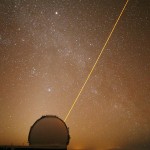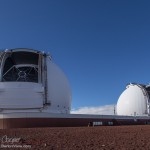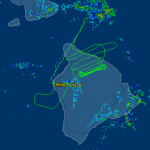TBAD is our Transponder Based Aircraft Detector, used to avoid illuminating an aircraft with the AO laser. A specially designed receiver that uses an antenna at the front of each telescope to detect the TCAS anti-collision transponder that is carried by all commercial and most civil aircraft.

Still, we are mandated to avoid the situation and to put in place measures to avoid such an occurrence. Before TBAD this involved hiring guys to sit outside and watch the skies for aircraft. I have done this, it can be pretty on a clear night with calm weather. It can be brutal on a cold and windy night. Even when taking precautions such as rotating two spotters every hour or two there is always the question of human fallibility under adverse conditions. Using an automated system like TBAD is far preferable.
We do need to prove that the system works. As one would expect, the FAA is an incredibly conservative organization. No surprise when the safety of millions of air travelers is at stake. When proposing a system to the FAA there are no half measures, you do it right or do not bother. Thus we test it, then test it again. Then we write a long and very detailed report of the testing.

Plan B? Charter an aircraft capable of flying high enough to properly test the system. A twin engine Cessna 421 from Pacific Air Charters with a pressurized cabin capable of flying at 30,000ft. Unfortunately I did not get to fly in the plane. That bit of fun went to my friend Eric while I was stuck supervising things on the summit and driving the Keck 2 telescope. No aerial photographs of the telescopes for Darker View.
We started early, awake at 03:30 and on the summit at 05:30 to prepare the telescopes for the day of testing. It was so early we were able to enjoy the bright summer Milky Way overhead as we drove up the mountain. We met the night time operators who were just getting ready to leave.

Thus we spent the day listening to Eric call each lettered pass on the radio, moving the telescope and dome to the right position, and watching the Cessna fly back and forth.
The weather shut things down the first day after accomplishing about half the flight plan. A set of thunderstorms developed over the Kona coast and over the airport. When the plane landed at Kona to refuel they rode through a very bumpy approach. The pilots called the test at that point. No matter, we would have had to close the domes as the convection reached the summit. It actually snowed enough to turn the ground white a short while after we left the summit for the day.
Our backup day was this last Sunday. Not quite so early a start, only an 04:30 alarm clock this time. Still it was a rush to complete the morning chores like filling LRIS and ESI with liquid nitrogen, doing the safety walkarounds and initializing the telescopes. We were ready and waiting as the aircraft climbed to altitude.
The day went smoothly, only one pass to re-fly at the end of the sequence. We think we have all the data needed to demonstrate the performance of the system. TBAD never failed to signal a laser shutter close as the aircraft passed in front of the telescope. The data will show us just what the safety margin is and the timing performance. Given satisfactory performance of the system we expect to operate without laser spotters in the next month or so.
In any case it was certainly a different sort of experience.


” I have stood in the high power beam, strong sunlight feels much warmer.”
Remind me to focus it down for you sometime.